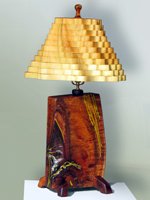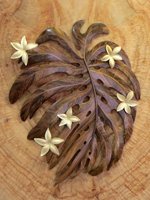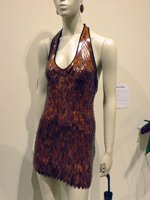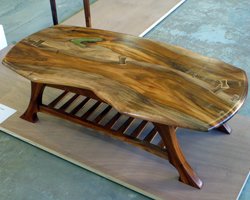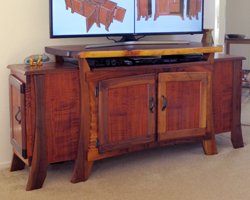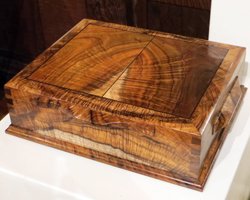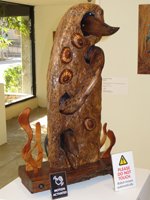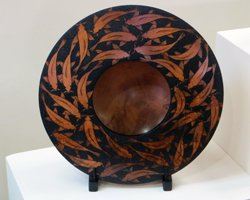Hawaiian Masterpieces at Hawaii’s Woodshow
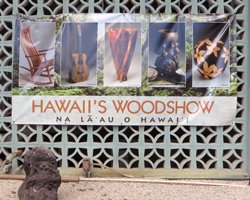
Location has varied
throughout the years
2 Weeks each year
(Dates have varied: September to December)
Hours have varied
from approx 10am to 5pm
Check for this year’s
location/schedule:
https://woodshow.hawaiiforest.org/
For more than 30 years, the Hawaii Forest Industry Association (HFIA) has hosted Hawaii’s Woodshow, which – as a hobby woodworker and HFIA member – is one of my favorite activities on the Hawaii event calendar (except, maybe, for two-time national champion University of Hawaii men’s volleyball season). In fact, the lamp pictured here, which is made from endemic Hawaiian Koa, Cook Island Pine, Monkeypod, and a few tiny bits of American Black Walnut was my first entry to the show as a novice. I didn’t win any prizes for it, but that just tells you that the other bespoke wood creations submitted that year were even more amazing!
Hand-Crafted Custom Woodwork at Hawaii’s Woodshow
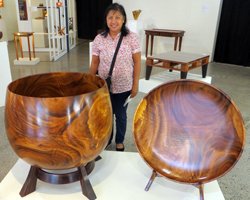
If you’ve ever watched any of those home renovation shows, car restoration shows, and/or YouTube videos of somebody building something, you probably get a certain satisfaction from seeing all the amazing things people can make.
Maybe, as a result, your taste in household furnishings (and/or your budget) has matured beyond the assortment of “assembly required” pressboard boxes sold in cardboard boxes at big box stores. Maybe you’ve grown tired of the mass-produced, yet uninspired selection of home décor found at most furniture stores. Heck, maybe you just woke up realizing that you need a wooden robot. I mean, who doesn't want that bragging right? Right? If any of this describes you, then Hawaii’s Woodshow is definitely for you.
From artistic wooden bowls, vases, wall-hangings, and other hand-crafted décor – through practical heirloom-quality furniture, instruments, game boards, cabinets, jewelry boxes, and handbags – to even the less practical (but no less delightful) custom wood creations such as a bicycle, dress, robots and surfboards… every bit of this and more has made an appearance one year or another at Hawaii’s Woodshow.
Please note, however, that the works submitted change each year. Every show offers a new range of local wood surprises by local artisans; and although endemic Hawaiian Koa (one of the most prized hardwoods in the world) is often prominently on display throughout the room, you’ll be surprised at the variety and beauty of the other native and locally grown species featured each year. For example, I made this coffee table from some Opiuma and Monkeypod that had just been cut by landscapers and was about to be thrown in the chipper. It may not have won best in show, but it's better than wood chips!
Much of the custom woodwork on display is available for purchase at Hawaii’s Woodshow. Therefore, if you’re in the market to buy, I suggest getting there on day one (and understand that you’re paying for one-of-a-kind, hand-crafted exotic wood pieces that tend to attract interest quickly). Some of the pieces, however, are not for sale. For example: I have not yet offered any of my pieces for sale because I’d rather use and enjoy what I’ve built. I built the entertainment center pictured here from curly Koa plywood and lumber, a Monkeypod slab, and American Black Walnut, but I did not even enter it in the show because: a) the percentage of non-Hawaii-grown woods would disqualify this piece; and b) I’d have to empty the contents and leave my TV on the floor for two weeks. No thanks. Nevertheless, many extraordinary pieces are for sale, so you too can enjoy your own functional art (after the show ends).
Responsible Stewardship of Hawaii’s Natural Resources
The wood use policy of Hawaii’s Woodshow promotes both productivity and sustainability. Because the event is sponsored by – and all contributing artists are members of – HFIA, the annual event is a celebration of the critical role Hawaii’s forests play in our island culture, craftsmanship, economy, ecology. Use of wood from trees grown in Hawaii is required; and use of readily available non-native species is encouraged. Endangered species are not permitted.
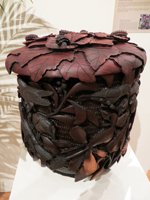
When you visit the show, be sure to talk to the volunteer docents (who also happen to be the artisans who created the pieces submitted). Ask them about the wood they used. Some will tell you where they were able to buy it; but most of the non-commercial species didn’t come from any store. More likely, they came from such exotic locations as the artist’s back yard, a neighbor / relative / friend, or a quick rescue from the chipper/compost heap.
Student Involvement in Hawaii’s Woodshow
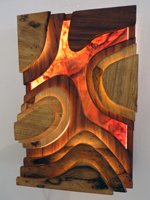
Not only does Hawaii’s Woodshow feature the master craftsmanship of Hawaii’s best professional and amateur woodworkers, but it also features the creative talents of Hawaii’s future masters. Each year, one or more local college(s) and one or more local high school(s) submit projects (created entirely by students) to the Innovation + Imagination Student Challenge. This includes student work from obvious classes such as wood shop, architecture, and design; but it has also included some exciting entries from one or more high school robotics team(s). The eel pictured here was a motion-activated working robot that “swam” through its hole in the reef each time somebody walked past. There were more than a few startled yelps that year!
Additional considerations at Hawaii’s Woodshow
In my opinion, the greatest sign of appreciation for fine woodwork is an uncontrollable desire to handle it. Woodwork is a tactile art form; and when done at the level of craftsmanship found at Hawaii’s Woodshow, it practically screams: “touch me!”, or worse: “sit on me!” And although most of the works submitted are safe to touch (very carefully and gently), they are still works of art like you might find in any gallery or museum.
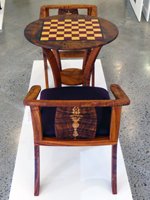
Therefore, please be alert for signs specifically asking you to refrain from touching certain pieces. Don’t let your kids sit down for a rest on somebody’s one-of-a-kind custom-built chair or bench; and don’t set your food or drinks down on somebody’s table. Basically, this is not the place to sit down for a game of chess – no matter how much you love the game! If needed, please ask one of the volunteer docents for assistance.
In fact, you are highly encouraged to talk to any of the volunteer docents. Woodwork is one of their favorite subjects, and they’ll tell you as much as you care to know about it. As an amateur hobby woodworker, I’ve benefitted from the wisdom of their experience a few times already. What can you learn?
